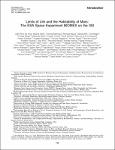Limits of Life and the Habitability of Mars: The ESA Space Experiment BIOMEX on the ISS
de Vera, Jean-Pierre
Alawi, Mashal
Backhaus, Theresa
Baqué, Mickael
Billi, Daniela
Böttger, Ute
Berger, Thomas
Bohmeier, Maria
Cockell, Charles
Demets, René
de la Torre Noetzel, Rosa
Edwards, Howell
Elsaesser, Andreas
Fagliarone, Claudia
Fiedler, Annelie
Foing, Bernard
Foucher, Frédéric
Fritz, Jörg
Hanke, Franziska
Herzog, Thomas
Horneck, Gerda
Hübers, Heinz-Wilhelm
Huwe, Björn
Joshi, Jasmin
Kozyrovska, Natalia
Kruchten, Martha
Lasch, Peter
Lee, Natuschka
Leuko, Stefan
Leya, Thomas
Lorek, Andreas
Martínez-Frías, Jesús
Meessen, Joachim
Moritz, Sophie
Moeller, Ralf
Olsson-Francis, Karen
Onofri, Silvano
Ott, Sieglinde
Pacelli, Claudia
Podolich, Olga
Rabbow, Elke
Reitz, Günther
Rettberg, Petra
Reva, Oleg
Rothschild, Lynn
Garcia Sancho, Leo
Schulze-Makuch, Dirk
Selbmann, Laura
Serrano, Paloma
Szewzyk, Ulrich
Verseux, Cyprien
Wadsworth, Jennifer
Wagner, Dirk
Westall, Frances
Wolter, David
Zucconi, Laura
BIOMEX (BIOlogy and Mars EXperiment) is an ESA/Roscosmos space exposure experiment housed within the
exposure facility EXPOSE-R2 outside the Zvezda module on the International Space Station (ISS). The design of
the multiuser facility supports—among others—the BIOMEX investigations into the stability and level of degradation
of space-exposed biosignatures such as pigments, secondary metabolites, and cell surfaces in contact with
a terrestrial and Mars analog mineral environment. In parallel, analysis on the viability of the investigated organisms
has provided relevant data for evaluation of the habitability of Mars, for the limits of life, and for the
likelihood of an interplanetary transfer of life (theory of lithopanspermia). In this project, lichens, archaea, bacteria,
cyanobacteria, snow/permafrost algae, meristematic black fungi, and bryophytes from alpine and polar habitats
were embedded, grown, and cultured on a mixture of martian and lunar regolith analogs or other terrestrial
minerals. The organisms and regolith analogs and terrestrial mineral mixtures were then exposed to space and to
simulated Mars-like conditions by way of the EXPOSE-R2 facility. In this special issue, we present the first set of
data obtained in reference to our investigation into the habitability of Mars and limits of life. This project was
initiated and implemented by the BIOMEXgroup, an international and interdisciplinary consortiumof 30 institutes
in 12 countries on 3 continents. Preflight tests for sample selection, results from ground-based simulation experiments,
and the space experiments themselves are presented and include a complete overview of the scientific
processes required for this space experiment and postflight analysis. The presented BIOMEX concept could be
scaled up to future exposure experiments on the Moon and will serve as a pretest in low Earth orbit. Key Words:
EXPOSE-R2—BIOMEX—Habitability—Limits of life—Extremophiles—Mars. Astrobiology 19, 145–157.
Files in this item

